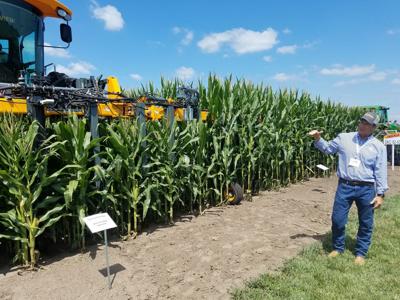Bayer sees a big future for short corn varieties

Bayer has high hopes for short corn.
Though still a few years from its expected release, field trials near Jerseyville, north of St. Louis, reflect the company’s belief that “short-stature corn” — grown on stalks about two-thirds the height of conventional varieties — could become the dominant type of corn in the U.S. over the next decade or so.
Bayer crop science officials say the shorter varieties use less water and produce more corn.
“I think it truly could transform the way we produce corn,” said Calvin Treat, a corn technology specialist within Bayer’s Crop Science Division, based in St. Louis.
The potential has raised lofty expectations within the company. Scientists like Treat and top-level executives alike think short corn could become the leading variety grown commercially.
The company could be onto something. For years, some independent scientists have suggested that tall, water- and fertilizer-intensive crops like corn “could benefit by becoming shorter and sturdier,” according to a 2011 analysis from Purdue University researcher Burkhard Schulz. “It is essential to change the architecture of plants to minimize how much land we need to produce food and fuels,” Schulz, now a professor at the University of Maryland, said in a Purdue release.
Short corn’s top selling point: Its seeds can be planted more closely together, giving farmers higher yields on less acreage.
The stouter structure of the plant also makes it less susceptible to issues such as “greensnap” or “stalk lodging” — terms for when corn plants break. Additionally, the reduced height makes the crop more compatible with farm machinery. Normal corn can be 10 feet or even 11 feet tall, which can be too tall for some machinery to access without damaging the stalks. But short corn, even at its tallest, is still short enough for combines and other farm tractors to drive over-top and re-fertilize, for instance, while the crop is still growing.
“I think it can be a real game-changer,” said Bob Reiter, Bayer’s head of crop science research and development. “I don’t see any reason why it couldn’t become the standard in the industry.”
Bayer is planning on giving short-stature corn seeds to some farmers in Mexico next year. But the crop still has years ahead of it before making its U.S. debut, according to Bayer officials. They estimate that it will become commercially available to domestic growers by 2022 or 2023.
Bayer has developed short corn via more traditional plant breeding. The company is working on a genetically modified variety that could reach the market a few years after that.
Of course, the crop will ultimately have to win over farmers, who could be hesitant to adopt a smaller version of the U.S. staple.
Treat, for example, acknowledges that farmers are highly in tune to “coffee-shop talk” about how crops physically look in the field and admits that it may be a challenge, at least initially, to fight the psychological perception that bigger is better. But he and others at Bayer expressed confidence that results from strong yields can, and will, win them over.
Along with advances in digital farming tools, Brett Begemann, chief operating officer for Bayer’s crop science operations, thinks short corn will make a lot of money for farmers, and for Bayer.
“Ten years from now, looking back, we’re going to say, ‘Wow, we didn’t know what we had,’” Begemann said. “It can be that big.”
Source : agropages